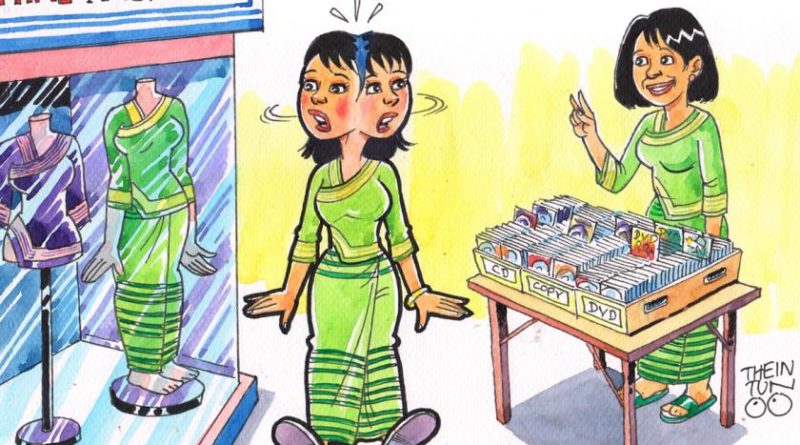FASHION: YANGON – What’s new, copycat?
Myanmar’s designers are pinning their hopes on a new copyright law
That people wear reveals as much of their personality as the cultural traits of their country. Creators and designers are not only business people making clothes or accessories for a living, but artists embellishing and also chronicling the ways of their own societies. As such, what they produce should be protected. If they are not, a bit of that heritage they represent may very well disappear.
In Myanmar, intellectual property is a nascent concept. The Myanmar Copyright Act, a hangover from the colonial era is still in the books. But it is a rather outdated text – it was adopted over a century ago, in 1914 – and one that Burmese decision-makers never debated or had ownership over.
A new homegrown version was approved by parliament last month, raising hopes that things will move in the right direction.
For today, designers are simply used to seeing their patterns and designs copied by local copycats. The loss of such a system is hard to measure. But one can only imagine how discouraging it may be to see one’s hard work and original ideas being copied and sold for much less. I’m sure many creators gave up on wonderful projects thinking “why bother?”
Another consequence of such a perverted system is that only people who are rich enough – and can afford to run a loss – enter the creative fields. Without a proper legal protection or adequate redress, ordinary people with little capital (a vast majority in our country) will not take the risk to invest the time and the little money they have in projects that can be copied in a matter of mere seconds.
Protection of intellectual property isn’t just a problem for the people with a taste for design. It matters to us all. Because of copycats, traditional patterns and designs are disappearing or being devalued. If local business take no pity on Myanmar’s designers, nor do our neighbours.
Mogok Pauk Pauk, a Burmese designer who has revisited Myanmar’s traditional cheik patterns says she is worried.”When we are weaving Cheik there are special notes for each pattern – this is what we call pin sarr. Most of those notes are already disappeared and weavers are making cheik longyi based on what they remember these notes are,” she adds. If intellectual property is protected, it is also stored and archived. Defending designers is also a way to preserve our culture.
She has long argued that designs should be registered and maintained within the Ministry of Religious Affairs and Culture. This is what’s in the new law. Under the section “traditional culture” designers like her can be protected, providing that they register.
This is a welcomed move. Some Thai companies, she says, have already registered recipes for Thanaka, the Burmese traditional make up.
Copycat’s eyes
But the enemy mostly comes from within. Local copycats are doing the most damage – cheik and thanaka are primarily worn and sold in Myanmar.
‘Shayi’ is a famous local brand. Her owner Sann Bauk Rar is trying to compete with copycats by having better quality material and a good advertising. This is vicious circle. Copycats take down prices for the not-so-well-off to buy them. The more they do, the more the prices of originals go up – the cheap stuff goes to the poorest and the primo stuff for the rich. Less people buy Sann Bauk Rar’s products. Everybody loses, except for the copycat who hasn’t done much work, and doesn’t take much risk. Well, at least for now.
The new law might be a step in the right direction, she says, but given the state of the Burmese judicial system, change will take a long time to happen. But she’s happy the authorities recognise that there is a problem. “It at least makes us respectable,” she says.
To make the copyright intellectual laws work, over 50 local designers organised the Myanmar Entrepreneur Fashion Designers Association.
“We were extremely surprised to see models walking on stage wearing our traditional cheik. We asked for intellectual law and copyright to the Ministry of Religious Affairs and Culture,” said Ma Myint Zu (Zu Zu’s Collections) chair of the Designers Association. They actively lobbied and were heard.
A law passed on February 15 lays the ground for copyrights in arts, literature, industrial design and a vaguely worded “new creation” sector. The bill renders void the Myanmar Copyright Act. It offers the designers the possibility of registering their creation. Offenders can be sentenced to three years in jail or K100, 000.
Copycats won’t disappear overnight, but they’ll have a harder time blatantly stealing others’ works. / Myanmar Times. / 02 MAR 2018
NOTE : All photographs, news, editorials, opinions, information, data, others have been taken from the Internet .. aseanews.net | [email protected] | For comments, Email to : Aseanews.Net | [email protected] Contributor









